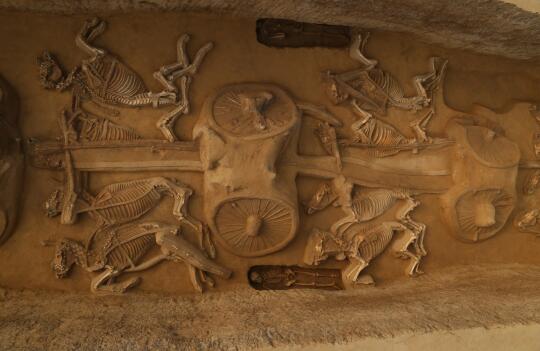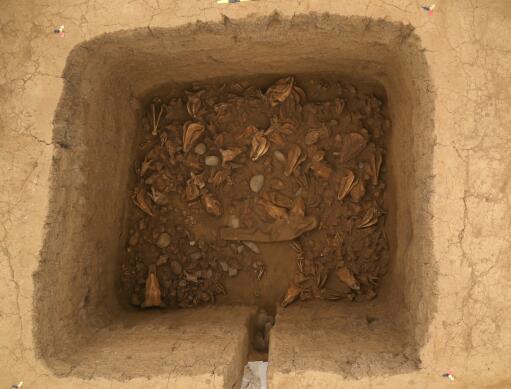New discovery in Gujun Site in Nanqiao Town, Hebei Province
From:Chinese Archaeology NetWriter:Date:2018-01-26
Since April 2016 to 2017, the Hebei Provincial Institute of Cultural Relic conducted an excavation in Gujun Site together with the Institute of Archaeology, Chinese Academy of Social Sciences (IA CASS), coving an areas about 7000 square meters, clearing up 36 tombs of Eastern Zhou Dynasty, 7 horse and chariot pits, 50 wells, 420 ash pits, 2 kilns, and 2 hearths, as well as thousands of bronze, gold, jade, pottery, mussel and bone wares were unearthed. Gujun Site was located in the north of Gujun Village, Nanqiao Town, Xingtang County, Hebei Provience, which was preliminary identified as noble cemetery of Rong and Di people in the northern tribes during late Spring and Autumn period to early Warring States periods, as well as the residential area during early Warring States period.
Aerial photo of tomb M53, Horse and chariot pit No.3 and its animal sacrifial pit
The cemetery was mainly stone tombs, and there were concentrated into 5 groups, which had 3 to 5 tombs and 1 to 2 horse-chariot pits. There were bronze wares or sacrificed sheep head in some tombs’ niche, while some filled with sacrificed pig and dog, and there were some bronze wares in waist pit. The differences between funerary utensile were a set of outer and inner coffin, just inner coffin, and without any coffin. The burial objects were bronze Ding tripod, gourd shaped hu pot, pot, yan vessel, Dou food container, Dui food container, Yi water container, basin, Fu boiler, spoon, sword, dagger-axe, arrowhead, belt buckle, gold earrings, gold leaf, turquoise, agate hook, jade ring, jade decoration, tube, crystal bead. Tomb M53 was 5.34 m from south to north, 5.58 m from east to west, while the main chamber was in east middle, one person was sacrificed in each four corner of side chamber, sets of bronze wares unearthed from the southeast niche, and there were a 24 m long horse and chariot pit as well as a 1 m long sacrificed animals pits 3 m away from the east of the tomb.

The chanmer of tomb M53
The horse and chariot pit had distinct features. There were one carriage with three horses, and the dog wore a bronze bell with stone shell decorated in Horse and Chariot Pit No.1.. No.4 to No.7 Horse and Chariot Pit shared a great similarity, which was separated with sacrificed pit (sacrificed with cow, sheep, horse etc.) by raw soil beam.

Horse and chariot pit No.2 and its animal sacrifial pit
Horse and Chariot Pit No.2 was 20.85 m in length from east to west, with 1 small chariot and 4 chariots with four horses. The small chariot located in the very east side without any pulling animals. The 4 chariots with four horses, which buried with 16 killed horses placed in the pulling position. The 4 chariots surface were colored with black and red or black, red and white lacquer or decorated with gold leaf. Several colored leather straps which was for pulling the chariot, were placed paralleled. Niches in both sides of the middle part of the pit were sacrificed with a male. Buried with five chariot, Horse and Chariot pit No. 2 was a rare sample for pre-Qin Period, which providing precious materials for restoring horse cart riding method of pre-Qin Period; there was sacrificed animal pit in front of the horse and chariot pit, which was filled with the head or hoof of ox, goat, and horse layers by layers with unique way. It was the first discovery ever found in China, which offering new materials for studying the funeral customs, sacrifice ritual or even the contribution for the related funeral customs (such as FengFu system) of pre-Qin period. The pit burial was with obvious characteristics of north group. The water wells were scattered together, which could be classified into round without crib ring and with pottery ring, rectangle with wooden ring and clay ring.

The carriage and horse skeleton in Horse and chariot pit No.2

Animal sacrifial pit in front of Horse and chariot pit No.2
The archeological excavation of Gujun Site supplied the gap of archaeological research in the middle part of Hebei Province in the same period. The tombs were narrow and deep filled with stones, animal head and hoof as well as bronze vessels, short straight sword, gold earrings, agate decoration , popular with human sacrifice and large number of animal sacrifice, while the horse and chariot decoration was unique, which was rare in the central China during the same period, which was the distinct characteristics of North group in China; Meanwhile, the funeral system of horse and chariot, bronze, pottery pattern, style and vessel combination, were greatly influenced by Central Plain Culture such as Jin and Yan(Shanxi and part of Hebei Province), these discoveries providing precious materials for the study of Rong and Di peoples in the northern tribes and formation of Chinese culture blending with multi-element. (Translator: Lang Langtian Photo: Archaeology Press IA CASS)

